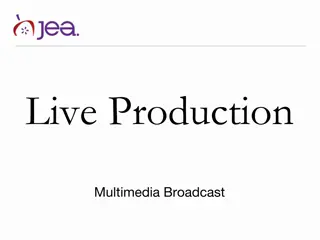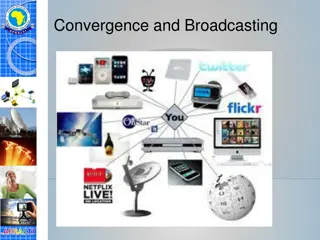The Future of Work in Broadcasting Sector: Emerging Trends and Challenges
In the broadcasting sector, changes in industrial relations, economic factors like wage inequality, job precarity, and social factors impacting job satisfaction and talent retention are shaping the future of work. The evolving labor market dynamics, technology disruptions, and the need for skill development present both opportunities and challenges for workers and organizations in this sector.
Download Presentation

Please find below an Image/Link to download the presentation.
The content on the website is provided AS IS for your information and personal use only. It may not be sold, licensed, or shared on other websites without obtaining consent from the author.If you encounter any issues during the download, it is possible that the publisher has removed the file from their server.
You are allowed to download the files provided on this website for personal or commercial use, subject to the condition that they are used lawfully. All files are the property of their respective owners.
The content on the website is provided AS IS for your information and personal use only. It may not be sold, licensed, or shared on other websites without obtaining consent from the author.
E N D
Presentation Transcript
The Future of Work in the Broadcasting Sector: Preliminary Results Naomi Isabirye, Trevor Ramittlwa, Hossana Twinomurinzi, Lateef Amusa
Political factors Industrial relations: How labor institutions evolve, changes in the nature of work, new forms of work are emerging and workers rights, incomes are compromised. Trade unions: Strong trade unions protect the interests of vulnerable workers and precarious jobs, and avert inequality, the influence of trade unions is threatened by changes in the forms of work Educational policy from institutions: Public educational policy should respond to the needs of the workplace and teach 21st century skills, and supportive programmes to keep vulnerable workers in the labor market (Gruen, 2017) Labor market: power between employers and workers is shifting with new forms of work such as gig work, telework; job market is more competitive, with workers settling for lower wages with no career progression or basic conditions of employment.
Economic factors Wage inequality: The balance of power causing a higher incidence of wage inequality; rising unemployment due to technology displacement and job polarization. Employment: Certain jobs are being made redundant, while the demand for certain workers in certain occupations is increasing and new jobs are emerging. Job Polarization: New technologies have reduced the demand for workers performing easily mechanized routine tasks; Low paid jobs are most affected by job losses associated with new technologies; There is a higher relative demand for jobs that that require greater creativity or manual or interpersonal skills; Jobs in the upper wage bands (that require creativity and problem solving) and lower wage bands (requiring manual labor) are in increasing demand.
Job precarity: There is a sense of job and income insecurity. Satisfaction: Changes in technology have affected the job satisfaction of workers. Social factors Burnout: Changes in technology have resulted in burnout of workers as they try to adapt. Work life balance resulted in a poor work life balance for workers as they try to adapt. : Changes in technology have Vulnerable workers: Certain demographic groups, particularly older workers and less technology savvy workers are at risk of job losses due to the changing demands of their jobs.
Talent: There are efforts to attract and retain the right talent to fit the new paradigm of jobs. Career: There is a need for constant career development to meet the changing demands on workers. Social factors Leader s values: Leaders values should respond to the needs of the organization and workers amidst the changing technological environment. Corporate social responsibility: Companies have a responsibility to engage in good governance, fair business practices and investment into developing their workforce and ultimately contributing to the talent pool of the market.
Technological Gig work: Gig workers fall within the classification of new forms of work, where workers have no long term formal contractual arrangements with an employer and operate as contractors to fulfill very specific roles or tasks. Telework: Refers to the ability to away from a formal, physical workplace. This form of work has become much more widespread since the start of the global Covid 19 pandemic. Automation: This phenomenon refers to the ability for jobs or tasks to be completed partially or fully by technology. New forms of work: New forms of work is an umbrella term that describes how traditional working arrangements are changing and relates to the place, time and nature of work, as well as the contract between worker and employer. Crowd work: Individuals outside of the organization can pitch to fulfil projects or roles.
Technological Innovation: Refers to changes in processes and systems that allow organizations to deliver products and services more efficiently and effectively. Digital Transformation: Refers to changes in the industry and organizations brought about by new digital technologies. E-HRM: Refers to changes in how the HR function is managed through digital technologies. HR Analytics: Data analytics can be used to monitor worker data and track performance. This is unsettling to workers and may lead to violations of worker privacy. Virtual HR: HR functions can be delivered effectively through employee self-service portals and other electronic mechanisms.
Job susceptibility Jobs are at risk.
Broadcasting sector Television The distribution of audio and video content to a large audience. Radio Online streaming services. Broadcasters, production studios, distribution companies, and advertisers. Wide range of players: The sector is constantly evolving as technology changes and new competitors enter the market
Frequency Percent Male Female 100 100 48.5 48.5 Valid Prefer not to say 6 2.9 Frequency Percent Matric or below 13 6.3 Demographics Diploma 56 27.2 Valid Degree or honors 104 50.5 Masters PhD 31 15.0 1.0 2 Std. Min Max Mean Deviation Age (Years) 21 56 31.71 7.02 Years of experience 0.5 35.0 6.77 4.86
There are adequate job opportunities Average score StdDev Count Content creator (e.g. producer, script writer, reporter...) Human Resource Practitioner Management 3.69 3.71 3.57 55 21 23 0.99 Presenters & anchors (e.g. actors, artists, presenters, contributors, anchors...) 3.60 55 Technical (e.g. engineers, cameraman, lights...) 3.48 52
Workers feel a sense of job insecurity. Content creator Presenters & anchors Technical 3.84 4.09 3.85
Jobs are at risk Jobs are at risk. StdDev Content creator (e.g. producer, script writer, reporter...) Human Resource Practitioner Management Presenters & anchors (e.g. actors, artists, presenters, contributors, anchors...) Technical (e.g. engineers, cameraman, lights...) 3.76 4.19 0.74 0.75 4.04 0.77 3.50 0.67
Fair wages Contract/freelance workers. Permanently employed workers 3.35 3.42 Content creator Human Resource Practitioner Management Presenters & anchors Technical 4.14 4.19 3.22 3.19 3.36 3.69
Certain occupational types are becoming redundant Content creator 3.73 Human Resource Practitioner 4.05 Management 3.78 Presenters & anchors 3.73 Technical 3.46
New occupations are emerging Content creator 3.872727 Human Resource Practitioner 4.047619 Management 3.652174 Presenters & anchors 3.745455 Technical 3.615385
Education is adapting to respond to the changing education and skills demands in the sector Private Public Human Resource Practitioner 4.38 4.00 Management 3.52 3.70
The job market has become more competitive. Content creator 3.89 Human Resource Practitioner 3.95 Management 3.78 Presenters & anchors 3.76 Technical 3.46
I have the capacity to adopt emerging technologies to fulfill my job role Content creator Presenters & anchors Technical 4.16 4.04 3.60
Older or less technology savvy workers feel insecure in their jobs Content creator 3.84 Presenters & anchors 4.07 Technical 3.90
Findings and conclusion The responses indicated a sense of job and income insecurity These conditions can all contribute to job susceptibility Job insecurity, can make workers more willing to accept less desirable job conditions, such as lower pay, longer hours, or fewer benefits Income insecurity can make workers more willing to accept any job that offers some income, regardless of the quality of the job or the conditions under which they work. These conditions also have implications for burnout and job satisfaction























